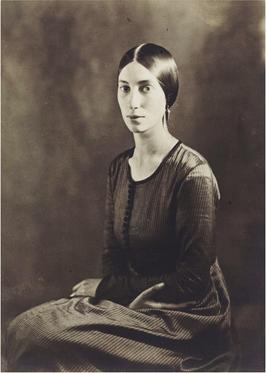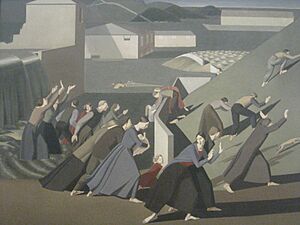Winifred Knights facts for kids
Quick facts for kids
Winifred Margaret Knights
|
|
|---|---|
 |
|
| Born | 5 June 1899 Streatham, London, England
|
| Died | 7 February 1947 (aged 47) London, England
|
| Education |
|
| Known for | Painting |
| Spouse(s) | Walter Thomas Monnington |
Winifred Margaret Knights (born June 5, 1899 – died February 7, 1947) was a talented British painter. She is famous for her paintings like The Marriage at Cana and The Deluge. The Marriage at Cana is now in the Museum of New Zealand Te Papa Tongarewa. The Deluge is kept at Tate Britain.
Winifred Knights' art style was inspired by Italian art from the 1400s, known as the Quattrocento. She was one of many British artists in the 1920s who brought back religious themes in their art. She also mixed in some modern art ideas.
Contents
Who Was Winifred Knights?
Winifred Knights was born in Streatham, South London. She was the oldest of four children. Her mother, Mabel, used to be a singer and embroiderer. Her father, Walter, worked for a sugar company.
Early Life and Art School
From 1912, Winifred went to James Allen's Girls' School in Dulwich. She showed a great talent for art very early on. In 1915, she won gold and silver medals from the Royal Drawing Society.
She then went to the Slade School of Fine Art to study art. She studied there from 1915 to 1917 and again from 1918 to 1920. Her teachers included Henry Tonks and Fred Brown.
During World War One, Winifred experienced a shocking event. In January 1917, she saw the Silvertown explosion at a factory. This event was very upsetting for her. She took a break from her studies and stayed at her cousins' farm. This farm became the subject of her 1918 painting, The Potato Harvest.
Winning the Rome Scholarship
After the war, Winifred returned to the Slade School. She started to use her own experiences in her art. She painted about war and peace, city and country, and the roles of men and women.
In 1919, she painted Leaving the Munitions Works. She also won the Slade Summer Composition Prize for A Scene in a Village Street with Mill-hands Conversing. This painting showed a female trade union worker.
The next year, she made history. She became the first woman in England to win the important Scholarship in Decorative Painting. This scholarship was given by the British School at Rome. She won it with her very famous painting, The Deluge.
In 1920, she got engaged to a fellow student, Arnold Mason. She then moved to Italy to complete her scholarship. She lived in a small village called Anticoli Corrado near Rome. In 1922, the Tate museum bought one of her Italian landscape paintings.
Life in Rome and Marriage
Winifred stayed in Rome until 1925. Her engagement to Arnold Mason ended. On April 23, 1924, she married Thomas Monnington, who was also an artist studying in Rome.
Her first big painting in Rome was The Marriage at Cana, finished in 1923. This large painting traveled to different countries for exhibitions. After that, it was put away for a long time. British museums, like the Tate, were not able to take the painting because of its size. In 1958, the painting was given to the National Art Gallery of New Zealand.
Winifred also helped her husband, Thomas Monnington, with his art projects. She would pose for him and sometimes helped paint parts of his finished works.
Later Works and Exhibitions
Winifred returned to the Slade School in 1926 and 1927. She showed her art at the Imperial Gallery and the Duveen Gallery. Her 1927 exhibition included The Santissima Trinita. This painting showed a pilgrimage to Vallepietra. Some people think this is her best work. It is rarely shown to the public but was highly praised when it was first seen.
Between 1928 and 1933, Winifred created the altarpiece Scenes from the Life of St Martin of Tours. This artwork was for the Milner Memorial Chapel at Canterbury Cathedral. The cathedral leaders did not like how slowly she worked. She was very sad when her artwork was moved to a less visible part of the church. Luckily, it has since been moved back to the main part of the cathedral. In 1929, Winifred was chosen to join the New English Art Club, but she never showed her work with them.
In 1933, Stephen Courtauld and his wife Virginia bought Eltham Palace. They asked Winifred and Thomas Monnington to help decorate the inside of the building. They worked with other designers on this project.
Final Years
Winifred spent a lot of time in the late 1930s drawing sketches for a big painting called The Flight into Egypt. She stopped working during World War II. She started painting again after the war. However, she passed away suddenly from a serious illness in London on February 7, 1947, at the age of 47.
Her death wasn't widely reported at the time. It wasn't until 2016 that a major exhibition of her work was held at the Dulwich Picture Gallery.
What is The Deluge?
To win the Rome Scholarship, students had to paint a scene of The Deluge. This painting had to be done in oil or tempera and measure 6 by 5 feet. They had only eight weeks to finish it.
Ten judges looked at the paintings, including famous artists like John Singer Sargent. Winifred's painting of the flood went through several changes. At first, it showed Noah and his family loading animals onto the Ark. But because time was running out, she made her painting simpler. It shows people running from the rising water and trying to get to higher ground. Noah’s Ark can be seen far away on the right.
Winifred's mother posed for the main figure holding a baby. Her partner at the time, Arnold Mason, posed for the male figure next to her and the man climbing the hill. Winifred herself is shown in the painting too, on the right side in the front. The floodwater in the painting was inspired by Clapham Common. The Deluge was shown at the British Pavilion during the Paris Exhibition in 1925.
Winifred Knights' Unique Style
Winifred Knights was known for her special way of dressing. She wore a style inspired by Italian peasant clothes from the 1800s. This included a loose, ankle-length skirt, a simple buttoned blouse, a wide-brimmed black hat, and coral jewelry.
She often included herself in her paintings. You can see her in The Deluge and The Marriage at Cana. In The Deluge, she is in the front on the right side. In The Marriage at Cana, she is the third person from the left, sitting at the table. In both paintings, she is wearing her unique style of clothing.


